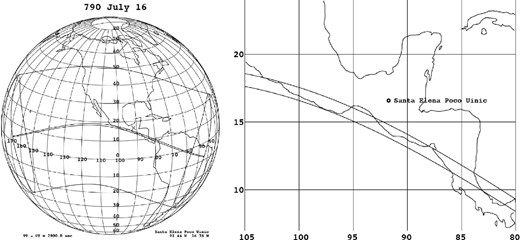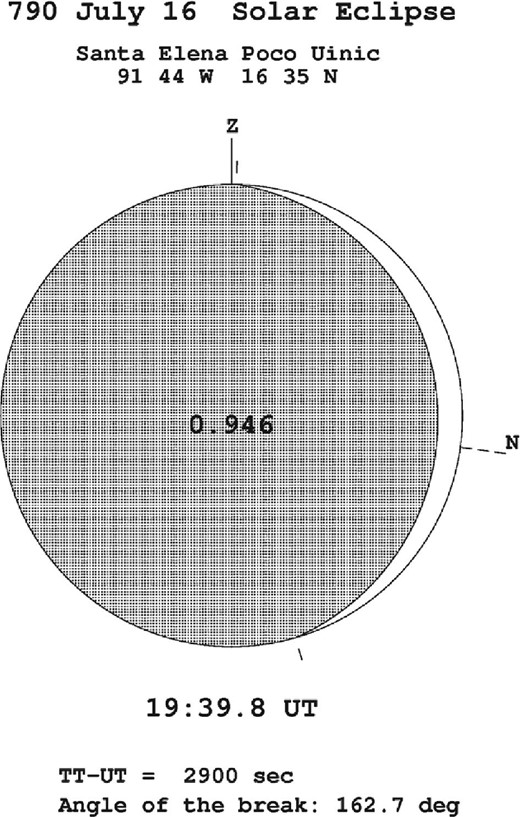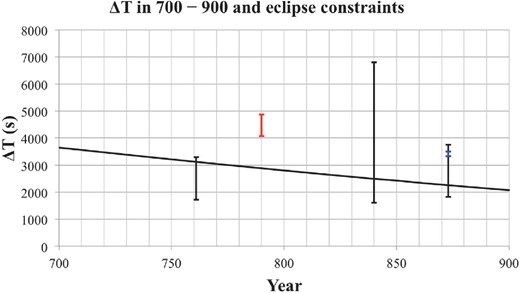-
PDF
- Split View
-
Views
-
Cite
Cite
Hisashi Hayakawa, Misturu Sôma, J Hutch Kinsman, Analyses of a datable solar eclipse record in Maya Classic period monumental inscriptions, Publications of the Astronomical Society of Japan, Volume 73, Issue 6, December 2021, Pages L31–L36, https://doi.org/10.1093/pasj/psab088
Close - Share Icon Share
ABSTRACT
Historical records of total solar eclipses provide vital information for computing the rotation of the Earth and understanding its long-term variations in the time before modern measurements. While eclipses recorded around Eurasia and North Africa for millennia have been subjected to consideration in this context, eclipse records in the American continents have received little attention. In this study, we analysed the solitary observational record for a solar eclipse conducted by the ancient Maya on 790 July 16 in the Julian calendar, recorded on the Stela 3 of Santa Elena Poco Uinic (N16°35′, W91°44′). This stela has an eclipse glyph and is associated with a total solar eclipse. Taking the up-to-date Earth rotation (ΔT) rate into account, our calculations locate this site slightly out of the totality path. The visibility of the total solar eclipse from Santa Elena Poco Uinic would require ΔT to be 4074 s < ΔT < 4873 s. In comparison with the contemporary eclipse records, this yields a short-term increase in ΔT ≥ 800 s between 761 and 790 and a decrease in ΔT ≥ 580 s between 790 and 873. Therefore, the total solar eclipse on 790 July 16 cannot be expected to have been visible from Santa Elena Poco Uinic, unlike what has been previously considered. We conclude that this stela probably records a partial solar eclipse of great magnitude (≈0.946) visible under favourable meteorological conditions or is based on hearsay from the southern coastal area.
1 Introduction
Total solar eclipses are spectacular astronomical events and have been recorded in various civilisations for millennia (e.g., Stephenson 1997; De Jong & Van Soldt 1989; Pasachoff & Olson 2014; Orchiston et al. 2015; Nakamura & Orchiston 2017). These events also provide observational opportunities that can aid scientific endeavours such as spectral analyses, visualization of variable coronal dynamics, and measurements of the variable rotation of the Earth (e.g., Sôma & Tanikawa 2015; Riley et al. 2015; Stephenson et al. 2016; Pasachoff 2017; Hayakawa et al. 2020, 2021). The visibility of total solar eclipses requires an exact apparent coincidence of the solar disk and the lunar disk. This condition forms a narrow path of totality within a wider zone where a partial eclipse is visible.
Thus, total solar eclipses provide vital information for the parameter ΔT related to the long-term variability of the Earth's rotation rate; ΔT is defined as the difference between a uniform timescale (terrestrial time = TT) and a timescale affected by the Earth's rotation (universal time = UT). Eclipse records have been surveyed on a millennial timescale (Stephenson 1997; Tanikawa & Sôma 2004; Sôma & Tanikawa 2015; Stephenson et al. 2016; Martínez Usó et al. 2016) in combination with historical occultation records (Sôma & Tanikawa 2016; Gonzalez 2017, 2019) to reconstruct the long-term ΔT variability, especially for the period before the systematic measurements with atomic time scales since the last century and observations of timed occultations since the 17th century (e.g., Calame & Mulholland 1978; Morrison et al. 1981; Herald & Gault 2012).
While records from various regions in Eurasia have been studied (e.g., Stephenson 1997; Stephenson et al. 2016), reports from the American continents have attracted little attentions in this context, despite the significant astronomical achievements of the ancient American civilizations (Aveni & Calnek 1999; Bricker & Bricker 2011; Vaquero & McKim Malville 2014). The Maya, with their highly developed calendar system (e.g., Teeple 1931; Thompson 1950; Kelley 1976; Bricker & Bricker 2011; Aldana y Villalobos & Barnhart 2014), have compiled extensive canonical eclipses in tables found in the Dresden Codex (Thompson 1972; Bricker & Bricker 2011; Aldana y Villalobos & Barnhart 2014; cf. Love 2017). In this context, we analyse a Maya eclipse stela that has been associated with a total solar eclipse in 790 (e.g., Palacios 1928; Teeple 1931; Bricker & Bricker 2011; Love 2017), in comparison with the long-term ΔT variability (e.g., Stephenson et al. 2016).
2 Stela 3 of Santa Elena Poco Uinic
Among the plethora of Maya stone monuments in the Maya Classic Period (CE 250–900), a unique record of a solar eclipse has been found at the site of Santa Elena Poco Uinic in Chiapas, Mexico, while some other inscriptions have been tentatively associated with solar eclipses (e.g., Bricker & Bricker 2011, p. 364). Santa Elena Poco Uinic is situated in the canyon region of Chiapas described as “spectacular” by P. Mathews,1 located in eastern Chiapas (N16°35′, W91°44′) southward from Palenque (C. Prager et al. 20142), and was possibly the capital of a small kingdom. Carved into the stone monolith known as Stela 3 (figure 1), the aforementioned inscription records observations on a solitary solar eclipse in the Maya civilisation with a glyph that is unique to solar eclipses (Teeple 1931, p. 115; Thompson 1935, p. 74; Martin & Skidmore 2012, p. 6; Kinsman & Asher 2017; Love 2017). It is dated “5 Kib 14 Ch’en” and long count “9.17.19.13.16” in the Maya calendar (Teeple 1931, p. 115), which converts to CE 790 July 16 in the Julian calendar under the Martin–Skidmore correlation (Martin & Skidmore 2012; Kennett et al. 2013; Iwaniszewski 2021). Studies have used the direct association of the Maya eclipse date with the actual solar eclipse on this date to derive the latest correlation between the Maya and Christian calendars, one of the popular conversions within the Maya studies (Martin & Skidmore 2012). Stela 3 was likely sculpted and commemorated on 790 October 8.

Eclipse glyph on Stela 3 of Santa Elena Poco Uinic. Panel (a) shows L. Orellana's overall trace copy for the Stela 3 in Palacios (1928, p. 124). Panel (b) shows M. O. de Mendizabal and F. Tannenbaum's photograph for its bottom part in Palacios (1928, p. 211). Panel (c) shows J. E. Teeple's close-up trace for the eclipse glyph in Teeple (1931, p. 115).
The eclipse glyph appears as the central hieroglyph in the bottom-most row of three hieroglyphs on Stela 3 and represents the event on the date immediately preceding this glyph. This hieroglyph has been iconographically interpreted as denoting the “disappearance of the sun” and has been associated with the total solar eclipse on this date (Teeple 1931, p. 115; see also Love 2017, p. 3). For this eclipse, Bricker and Bricker (2011, p. 364) stated: “A total solar eclipse affected the entire Maya area three days later, on AD 790 July 20 [NB in Gregorian calendar] at about 1:00 p.m., with the path of centrality passing directly over Chiapas,” using another calendar conversion. While this interpretation is widely accepted by Maya studies’ scholars, its phonetic reading in the parlance of hieroglyphic writing is controversial. The k’in, or Sun sign, similar to a four-leaf clover, is in the centre of the hieroglyph flanked by two cross-band signs, which are possibly sky signs (Martin & Skidmore 2012, p. 6). These twin wing-like signs are similar to the flanking motifs found in the Dresden Codex in what some scholars call “eclipse” glyphs (e.g., Bricker & Bricker 2011; C. Prager et al. 20063). However, most recently, Love (2017) argued against the connection of these eclipse “look-a-likes” to the hieroglyph found at Poco Uinic. Further, since the eclipse glyph on Stela 3 is unique in the corpus of Maya hieroglyphic inscriptions, despite many similar glyphs purported to refer to eclipses (Martin & Skidmore 2012, p. 6; figures 3 and 4), a viable phonetic reading for the glyph is challenging.
3 Eclipse visibility and Earth's rotation rate
In contrast, our calculations using up-to-date variable Earth rotation locates Poco Uinic slightly out of the totality path. To compute the totality path, we calculated the coordinates of the Sun and Moon with JPL ephemerides DE431 (Folkner et al. 2014) and applied the existing ΔT ≈ 2900 s in 790 based on Stephenson, Morrison, and Hohenkerk (2016). The results of our calculations are demonstrated in figure 2, which shows the eclipse's totality path passing off Santa Elena Poco Uinic. At this location, a partial eclipse was visible during 11:47–14:59 LT (apparent solar time), and the eclipse magnitude reached only 0.946, even at its maximum at 13:29 LT (figure 3). This slightly contradicts the notion that this stela records a visible total eclipse on 790 July 16 (e.g., Teeple 1931; Bricker & Bricker 2011; Martin & Skidmore 2012; Love 2017). In this case, it was probably challenging to see the solar disk during partial eclipse without appropriate filters (e.g., Chou 1997; B. R. Chou 20164).

Totality path of solar eclipse on 790 July 16 (a) and its close-up around Santa Elena Poco Uinic (b), calculated assuming ΔT ≈ 2900 s in 790 based on Stephenson, Morrison, and Hohenkerk (2016). These figures show that the total eclipse was seen only along the Pacific coast of Mesoamerica, whereas a partial eclipse was seen widely in Mesoamerica.

Eclipse seen at Santa Elena Poco Uinic at highest magnitude (0.946) at 13:29 LT, calculated with the ΔT ≈ 2900 s in 790 based on Stephenson, Morrison, and Hohenkerk (2016).

4 Summary and discussions
In this study, we analysed the solitary Maya observation of a datable solar eclipse on Stela 3 of Santa Elena Poco Uinic, which has been interpreted to mean the “disappearance of the sun” on 790 July 16, indicating the observation the total eclipse from its site (N16°35′, W91°44′). While its iconographic interpretation of a solar eclipse seems robust, the phonetic interpretation is still controversial.
In contrast, our calculation with the latest ΔT (≈2900 s in 790; Stephenson et al. 2016) concluded that this site was off the totality path of this eclipse and that only a partial eclipse would have been visible from there. The maximum magnitude of the partial eclipse is calculated as 0.946 at 13:29 LT during its period of visibility: 11:47–14:59 LT on 790 July 16. For the total solar eclipse to have been visible from this site, ΔT in that year should have to be significantly larger (4074 s < ΔT < 4873 s) than the current estimate of ΔT ≈ 2900 s (Stephenson et al. 2016). In comparison with the existing constraints in Stephenson, Morrison, and Hohenkerk (2016), this would require a short-term increase in ΔT ≥ 800 s between 761 and 790, making the visibility of the total eclipse from this site (Teeple 1931; Love 2017) unlikely.
While naked-eye observations of partial eclipses are challenging even at high magnitudes (e.g., Chou 1997; B. R. Chou 20164), several possibilities have been suggested. First, the Maya could have seen this deep partial eclipse under favourable meteorological conditions, such as a thin cloud cover as a natural filter. Actual cases of observational reports of naked-eye sunspot and Venus transit through cloud cover (e.g., Willis et al. 2018; Hayakawa et al. 2019) have demonstrated that the solar disk can be visible under favourable meteorological conditions. In this case, given the great eclipse magnitude (0.946 at its maximum), it would most likely have been noticeable from Santa Elena Poco Uinic through suitable natural filters.
As the Chiapas region in July would be in the middle of a rainy season, such a thin cloud cover is something that could be easily expected, even in the present times. The forest canopy was most probably much denser in the Classic period. Alternatively, residents of Santa Elena Poco Uinic may have received reports of the total eclipse from their neighbours in the southern territory, as extensions of the Maya settlements in the Classic Period are confirmed to have extended southward (e.g., figure 1 of Taladoire 2015). In this case, these reports would have been brought from the southern territory of the current Guatemala.
Therefore, our analyses confirm that the solar eclipse of Santa Elena Poco Uinic Stela 3 was indeed astronomically observable from the said site on 790 July 16, not as a total eclipse but as a deep partial eclipse, in contrast with what has been previously considered (e.g., Bricker & Bricker 2011, p. 364). Given current known evidence, for the total eclipse to be visible from this site would necessitate a short-term increase in ΔT ≥ 800 s between 761 and 790, which is slightly unrealistic. This makes observations of a great partial eclipse under favourable meteorological conditions, or hearsay of the totality from the southern sites, more plausible compared to a total eclipse observation.
Footnotes
Mathews, P. Who's who in the Classic Maya World: Santa Elena Poco Uinic (FAMSI), 〈http://research.famsi.org/whos_who/sites.php?sitename=Santa%20Elena%20Poco%20Uinic〉.
Prager, C., Gronemeyer, S., Wagner, E., Matsumoto, M., & Kiel, N. 2014, A checklist of archaeological sites with hieroglyphic inscriptions 〈https://mayawoerterbuch.de/archaeologicalsites/〉.
Prager, C. 2006, Is T326 a logograph for NA:M “hide, to go out of sight”? 〈https://www.academia.edu/821971600〉.
Chou, B. R. 2016, Solar Eclipse Eye Safety 〈https://eclipse.aas.org/sites/eclipse.aas.org/files/Chou-Solar-Eclipse-Eye-Safety-AAS-2016.pdf〉.
Acknowledgements
We thank Barbara MacLeod and Carlos Pallan for their helpful advice and discussions on the philological interpretations. HH thanks Masaki Kuwada for her hospitality during his fieldwork and Yuri I. Fujii for her help on accessing Palacios (1928). HH also thanks Gioacchino Falsone, Marshall Becker, Anita Fahringer, So Miyagawa, and Yukiko Kawamoto for their advice. This work has been supported with JSPS Grant-in-Aids JP20K22367, JP20H05643, and JP21K13957, JSPS Overseas Challenge Program for Young Researchers, Young Leader Cultivation (YLC) program and the ISEE director’s leadership fund for FY2021 of Nagoya University, the YLC collaborating research funds in 2020–2021, and the research grants for Mission Research on Sustainable Humanosphere from Research Institute for Sustainable Humanosphere (RISH) of Kyoto University.
Conflict of interest
The authors declare no known conflicts of interests.
Data availability
The original Maya stela is situated at Santa Elena Poco Uinic. We have consulted its photograph and copies in Palacios (1926). We have computed the coordinates of the Sun and Moon with NASA JPL ephemerides DE431 (Folkner et al. 2014) and derived the ΔT variability from Stephenson, Morrison, and Hohenkerk (2016).



